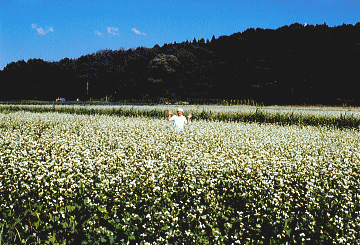
The introduction sentence of media

OLD NIC'S NOTEBOOK
MIST OPPORTUNITY
SEIZED
Buckwheat booze lifts locals'
spirits
By C.W. NICOL
The first flurries of snow
usually fall here where I live in Kurohime in mid-November, just at the start of
the hunting season.
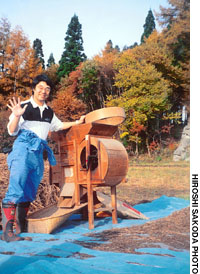 |
| Hiroshi Sakoda, whose idea it was to brew and distill shochu
using local buckwheat, husks the grains (above) to prepare them for the still. |
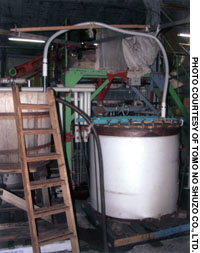 |
As I write this we are already into December, and although the top of the
"Black Princess" (Mount Kurohime) is dusted with white, and we get frost in the
mornings, snow has yet to come. So here's hoping for some powdery slopes to
please the skiers in the new year.
As of late, however, in the summer we have had another natural dusting of
white across the countryside in this beautiful corner of Nagano Prefecture. Most
of the farmers who let their paddies or fields go fallow, for whatever reason,
allow them to become overrun with weeds. There are a few, though, who take pride
in their calling and switch to other crops. One of these is buckwheat, which has
very attractive small flowers, usually white.
This area is famous for its very tasty buckwheat, a crop that seems to prefer
the cooler highlands, and also loves mist. Local farmers say that the mist
imparts a certain delicate taste. We certainly have a lot of mist here in
Kurohime, especially in the summer.
Some years back, onto the local scene came a former adventurer-sailor,
Hiroshi Sakoda, who crewed on the famous sailing ships Nihon Maru, Kaiyo Maru
and others. He and his family settled in Kurohime and built a pension called By
the Wind.
Sakoda struck up a friendship with another young human import, Ken Takahashi,
who married the daughter of the proprietor of Yorozuya, the sake shop close to
Kurohime Station. Spurred on by their son-in-law's enthusiasm, the family
modernized the business and began stocking not only the standard selection of
sake and beer, but also fine wines, whiskies, rums, gins, cheeses and a great
selection of shochu.
Shochu has become a very acceptable drink nowadays, and for the last three
years there has been talk of a "shochu boom," together with stories of rare and
mysterious brands that fetch even higher prices than the best single-malt
whiskies. The two newcomers to Kurohime resolved to combine forces to create
their own, locally produced brand of the newly fashionable liquor together.
Part of the reason is that Japanese sommeliers began to take notice of shochu
brands that had been allowed to mellow and mature for a few years. Allowing the
stuff to age is especially good for shochu brewed from rice or barley.
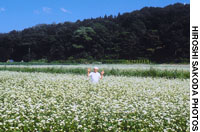 |
| Fields of flowering buckwheat (above) growing pesticide-free
around Kurohime to provide the grain for our new local shochu; harvesting the
crop. |
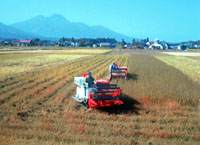 |
When I first came to Japan in 1962 and began drinking with friends from my
karate dojo, I was introduced to some awful rotgut firewater, supposedly a kind
of shochu, with names such as Bakudan (bomb) and Hanatare (snot nose). We drank
this stuff in rowdy, smoky yakitori places under the overhead tracks of
the older Tokyo train stations, favorite hangouts for day laborers, the rougher
kinds of university students and salarymen whose wives were stingy with their
pocket money.
A couple of glasses of this stuff afforded a quick, cheap and nasty way to
get hopelessly drunk, followed the next day by the most terrible, head-splitting
hangover. Even this Celtic boozer was quickly cured from ever wanting to touch
the stuff again. The only hooch I've tasted that was worse than that was the
illegal vodka used by the local mafia to pay reindeer poachers in Kamchatka . .
. but that's another story.
In 1975, when I got one of the cushiest jobs in my life, that of assistant
manager to the Canadian Pavilion at the International Ocean Expo in Okinawa, I
developed a real liking for the Ryukyu version of shochu, called awamori,
which is brewed, and then distilled, from imported Thai rice. The Okinawa
pavilion served a special drink during the Expo, one made of crushed ice,
squeezed local limes and awamori. It was marvelous.
Then, five years later, down in the Antarctic with the Japanese whaling
fleet, a gunner introduced me to a Kyushu shochu that was brewed and distilled
from sweet potatoes. It tasted a bit pungent at first go, but I soon got to like
it, either served with iceberg ice (that crackles and pops as it melts,
releasing tiny bubbles of compressed air) or cut with hot water and a pickled
umeboshi plum.
The gunner claimed that shochu was better for his health than sake or whisky.
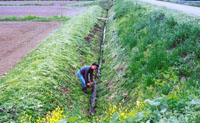 |
| A farmer weeds by hand rather than using herbicides (above);
raking over sun-drying buckwheat. |
 |
Since then, traveling frequently as I do to Kyushu, I have developed a real
liking for shochu, far preferring it to sake, which is much too sweet for me --
and also gives me horrible hangovers.
But back to those two friends, Messrs Sakoda and Takahashi. Sakoda got a
notion to brew and distill shochu using the local buckwheat as a base. The
neighboring community of Togakushi has long been famous for its buckwheat
noodles, so it is a traditional crop in these parts.
There are various brands of buckwheat shochu on the market, but nearly all
are made from freeze-dried grains, most of which come from China. These two
friends wanted a shochu made from fresh local buckwheat, grown without
pesticides and then naturally sun-dried. They looked around for good water
sources and decided on a spring that has been used for millennia by the oldest
community in our area, a village called Furumi that is now in the town of
Shinanomachi.
Furumi, at the foot of Mount Madarao, and on the shores of Lake Nojiri, has
been a site of human settlement since the time man hunted big-horned elk and
Naumann elephants, about 30,000 years ago.
Takahashi then sought out a local brewer-distiller and found Tomo no Shuzo
Co. Ltd., in Saku, Nagano. They ran a few tests, the results of which came my
way last summer. It was the best buckwheat shochu I'd ever tasted.
In November 2004 they produced 600 kg of pesticide-free, sun-dried buckwheat,
which was converted to 1,507 bottles of shochu that they have labeled Kurohime.
It is 25 percent alcohol, and is run just once through the still -- unlike
whisky or brandy, which are distilled twice, sometimes even three times, to
increase the alcohol content.
The success of their enterprise has spurred other local pension-owners to
join in and get farmers to loan them fallow paddies and fields to grow more
organic, mist-cooled buckwheat. So now, we can look forward to more snowy-white
summer fields -- and more fine shochu.
From a naturalist's point of view, this pesticide-free buckwheat is a great
attraction to honey bees and butterflies, and as the farmers also refrain from
using herbicides on the banks of the fields and paddies, instead cutting back
weeds by hand in the traditional way, this is also far kinder to insects and
birds.
More than anything else, though, to have an excellent locally produced drink,
the outcome of the dreams of two young friends, is yet another reason to feel
very good about living in Kurohime.
The Japan Times: Jan. 6, 2005
(C) All rights
reserved
